Cuisine du Sud du Vietnam : 10 plats à absolument essayer
Embarquez pour un voyage savoureux à travers le Sud du Vietnam, où la cuisine est aussi vibrante et diversifiée que le paysage lui-même. Cette région, connue pour ses terres fertiles et ses influences multiculturelles, offre une riche palette de plats qui éveillent les papilles. Découvrez la douceur crémeuse du lait de coco frais dans des plats comme le banh xeo, la saveur acidulée du bun thit nuong, et les vivantes street foods des marchés animés. La scène culinaire du Sud du Vietnam est un festin pour les sens, alliant des techniques ancestrales aux ingrédients locaux pour créer des expériences gastronomiques inoubliables.
Vietnam
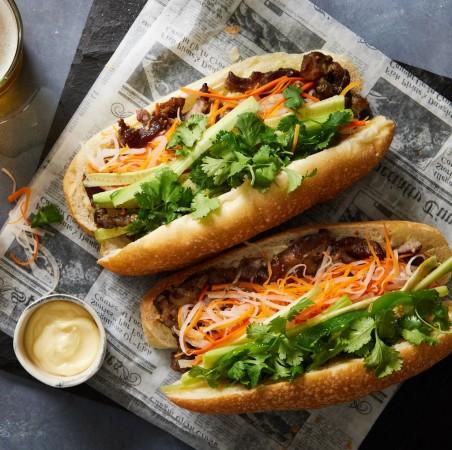
1. Pho du Sud
Le pho, la soupe de nouilles vietnamienne par excellence, possède une histoire fascinante qui commence au nord mais trouve véritablement son épanouissement dans le sud. La version du sud du pho est connue pour ses nouilles légèrement plus épaisses et un bouillon à la fois sucré et audacieux. Ce plat est servi avec un assortiment d'herbes fraîches, de germes de haricots mungo, et une symphonie de saveurs provenant des sauces chili et hoisin. Chaque cuillerée révèle un plat qui a voyagé et évolué, capturant l’essence des goûts et des traditions régionales.
Dans le Sud du Vietnam, le pho est plus qu'un simple repas ; c'est un rituel quotidien apprécié. À l'aube, les coins de rue animés se remplissent de locaux qui se retrouvent pour leur bol de pho du matin. Le bouillon, mijoté pendant des heures avec des os et des épices, dévoile une complexité de saveurs qui apportent à la fois réconfort et familiarité. Le pho du Sud, avec ses couches supplémentaires de douceur et ses herbes aromatiques, reflète l'abondance de la région et son patrimoine culinaire, en faisant un aliment de base dans l'alimentation locale et un plat incontournable pour les visiteurs.
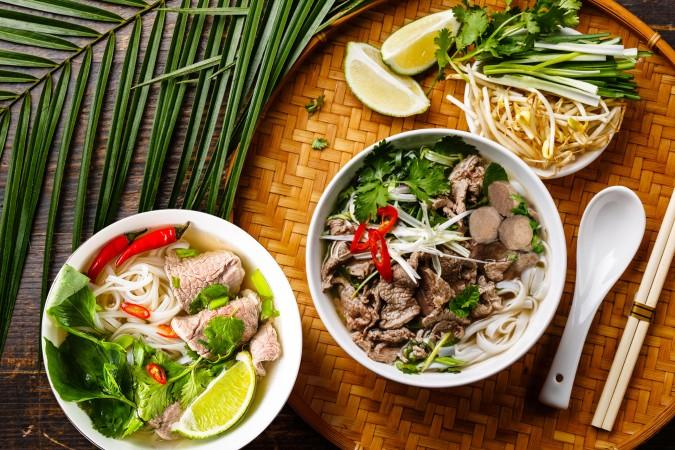
Pho du Sud - © Asian Inspirations
2. Banh Mi
Aucun voyage au Vietnam n'est complet sans déguster un banh mi. Ce sandwich modeste, né de la fusion des baguettes françaises et de l'ingéniosité vietnamienne, est un pilier de la culture de la street food. Avec sa baguette croûtée remplie d'un mélange de viandes, de légumes marinés et d'un savoureux mélange de sauces, le banh mi Saigon offre un goût d’histoire et un aperçu de la vie quotidienne dans le Sud du Vietnam. Il est classé parmi les 6 street foods les plus délicieux au monde selon TasteAtlas, un atlas culinaire international.
L'histoire du banh mi est celle de l'adaptation et de la créativité. Introduite par les Français durant leur période coloniale, la baguette a été transformée par les Vietnamiens en un plat qui leur est propre. Les vendeurs assemblent habilement ces sandwiches, superposant pâté, charcuterie et herbes fraîches d'une main rapide et experte. Chaque ingrédient, des carottes marinées croquantes à la mayonnaise crémeuse, ajoute une explosion de saveurs et de textures. Le banh mi n'est pas qu'un simple sandwich ; c'est un symbole de la capacité du Vietnam à prendre des influences étrangères et à les transformer en quelque chose d'extraordinaire.
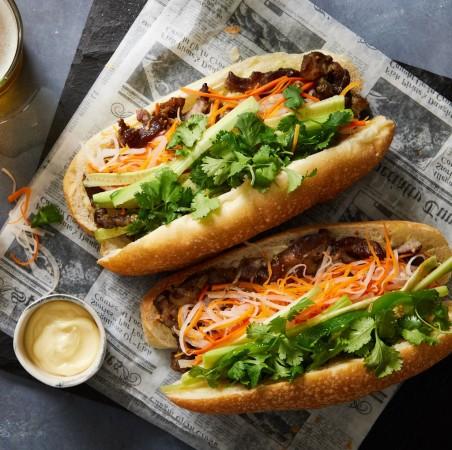
Banh Mi - © Delish
3. Bun Thit Nuong
Le bun thit nuong est une délicieuse évolution du plat du nord bun cha, offrant une expérience culinaire unique. Ce plat présente des côtelettes de porc grillées et tendres, marinées à la perfection et servies sur des vermicelles de riz fins, le tout posé sur un lit de légumes frais. Arrosé d'une sauce de poisson savoureuse, le bun thit nuong atteint un équilibre harmonieux, à la fois léger et satisfaisant, idéal pour la chaleur tropicale.
Le secret du bun thit nuong réside dans sa marinade, un mélange parfumé de citronnelle, d'ail et de sauce de poisson qui infuse le porc de saveurs savoureuses. Lorsque le porc grille, il dégage un arôme irrésistible qui attire les gens depuis la rue. Le plat est un délice sensoriel, avec le croquant des légumes frais, la texture des vermicelles et le porc tendre et fumé créant une parfaite harmonie. Chaque bouchée offre un voyage à travers les saveurs du Sud du Vietnam, faisant du bun thit nuong une expérience incontournable pour tout amateur de cuisine.
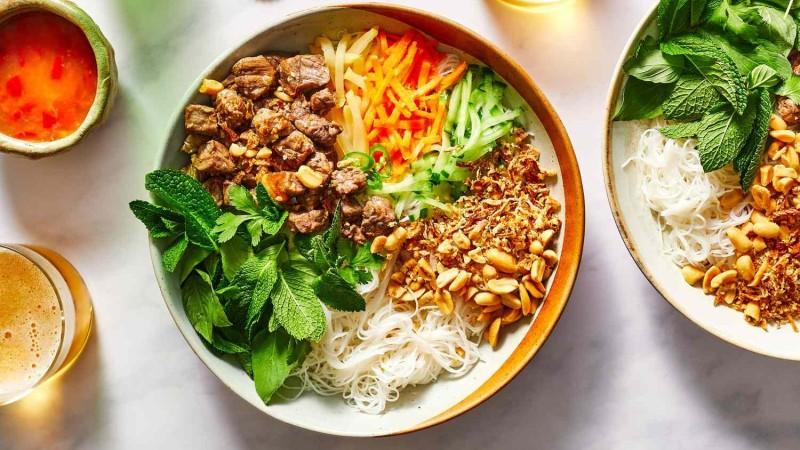
Bun Thit Nuong - © The Spruce / Cara Cormack
4. Hu Tieu Nam Vang
Le Hu Tieu Nam Vang, un plat de nouilles qui reflète le melting-pot culturel du Sud du Vietnam, est un favori de la street food. Des nouilles de riz moelleuses nagent dans un bouillon riche préparé à partir d'os de porc, surmonté de diverses viandes et fruits de mer. Chaque bol éclate de saveurs et de textures, du cœur de porc tendre aux germes de soja frais et aux ciboules. Que ce soit en version humide ou sèche, le Hu Tieu Nam Vang met en valeur la diversité culinaire du Sud du Vietnam.
Les origines du Hu Tieu Nam Vang remontent aux influences cambodgiennes et chinoises, illustrant la riche toile culturelle de la région. Le bouillon, clair mais profondément savoureux, résulte de plusieurs heures de mijotage des os de porc. Le Hu Tieu Nam Vang traditionnel inclut du porc haché et des crevettes succulentes, chacun apportant une texture et un goût uniques. En savourant chaque cuillerée, on peut sentir l'agitation des marchés de Saigon et la culture vivante de la street food, faisant de ce plat un incontournable pour les explorateurs culinaires.
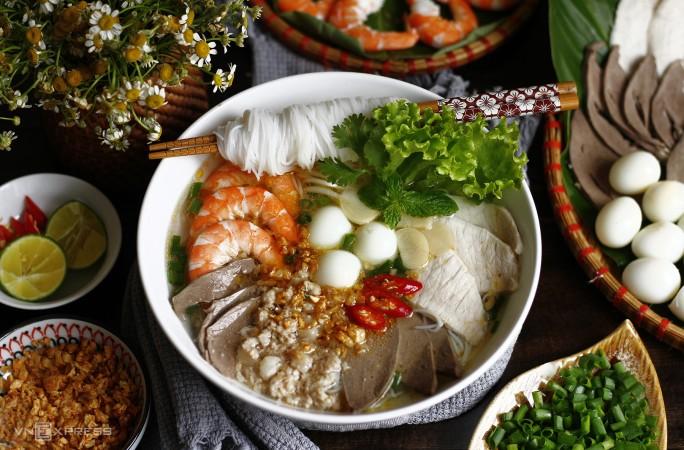
Hu Tieu Nam Vang - © Vnexpress
5. Goi Cuon
Le Goi Cuon, ou rouleaux de printemps frais, capture la fraîcheur et la vitalité de la cuisine vietnamienne. Le papier de riz translucide enveloppe des légumes croquants, des crevettes succulentes et du porc tendre. Chaque bouchée est une explosion rafraîchissante de saveurs, complétée par une sauce de trempage acidulée. Le Goi Cuon invite les convives à découvrir les délices légers, sains et aromatiques qui définissent la cuisine du Sud du Vietnam.
L'art de préparer le Goi Cuon réside dans l'équilibre des textures et des saveurs. Le délicat papier de riz enveloppe un mélange d'ingrédients sans se déchirer. À l'intérieur, un mélange de vermicelles, d'herbes fraîches et de protéines savoureuses se marie harmonieusement. La sauce de trempage, souvent un mélange de sauce de poisson, ail, chili et jus de lime, apporte une touche piquante. Manger un Goi Cuon, c'est comme savourer une journée fraîche et ensoleillée dans le Sud du Vietnam, en faisant un plat incontournable pour tout visiteur.
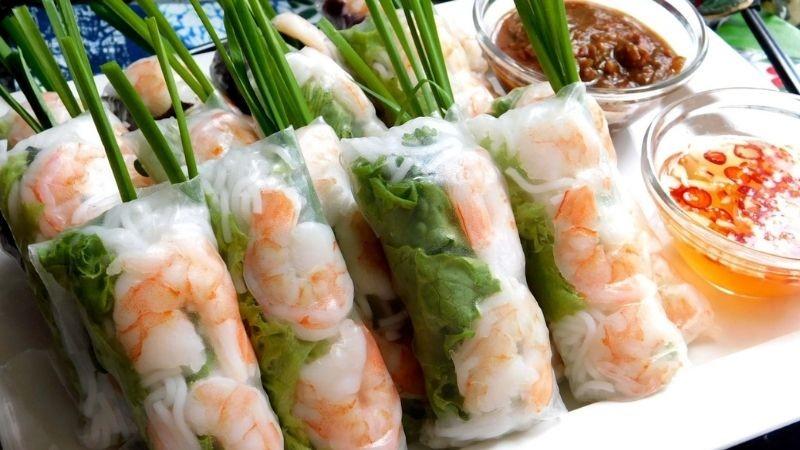
Goi Cuon - © rassembler
6. Com Tam
Le Com Tam, autrefois un repas modeste pour les paysans, s'est transformé en l'un des street foods les plus délicieux du Vietnam. Une assiette de riz brisé tendre se marie avec du porc grillé, un œuf frit et une sauce de poisson savoureuse. La simplicité du Com Tam cache des saveurs riches et des textures satisfaisantes, en faisant un plat incontournable pour ceux qui explorent le paysage culinaire du Sud du Vietnam.
À l'origine, le Com Tam utilisait des grains de riz brisé considérés comme moins désirables. L'ingéniosité vietnamienne a transformé cela en un plat bien-aimé, riche en saveurs et en histoire. Les vendeurs de rue servent le Com Tam avec l'arôme du porc grillé qui attire les clients. Le riz brisé absorbe la sauce de poisson, tandis que le porc grillé ajoute une note fumée et savoureuse. Chaque élément, de l'œuf frit croustillant aux légumes marinés, se mélange harmonieusement, reflétant l'ingéniosité et la créativité de la cuisine du Sud du Vietnam.
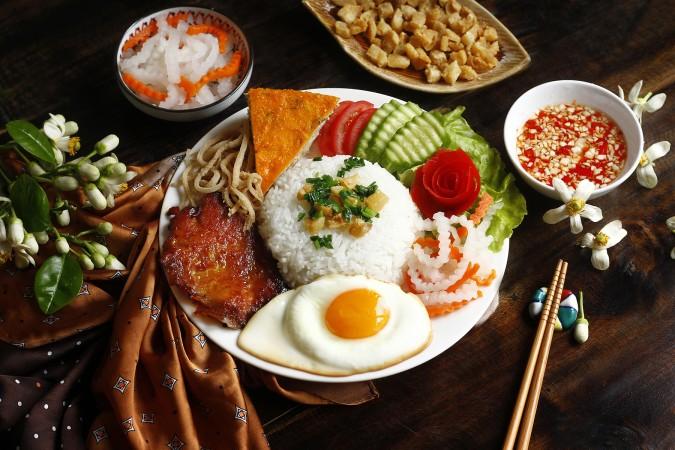
Com Tam - © VnExpress/Bui Thuy
7. Cao Lau
Originaire de Hoi An, le Cao Lau est imprégné de tradition et de mystère. Des nouilles épaisses, similaires aux udon japonaises mais typiquement vietnamiennes, sont garnies de tranches de porc grillé, d'herbes fraîches et de crépites de porc croquantes. La légende raconte que le véritable Cao Lau est préparé avec de l'eau du vieux puits Ba Le de Hoi An, ajoutant une touche de magie à ce plat envoûtant.
Le Cao Lau est lié à l'histoire riche du commerce de Hoi An, reflétant les traditions culinaires chinoises, japonaises et vietnamiennes. Les nouilles, plus fermes et plus moelleuses que les nouilles vietnamiennes habituelles, associées au porc grillé savoureux et aux herbes fraîches, créent une texture et une saveur uniques. Les crépites de porc croquantes ajoutent une couche supplémentaire de texture, rendant chaque bouchée délicieuse. Le Cao Lau offre un goût du passé historique de Hoi An et de son présent vibrant.
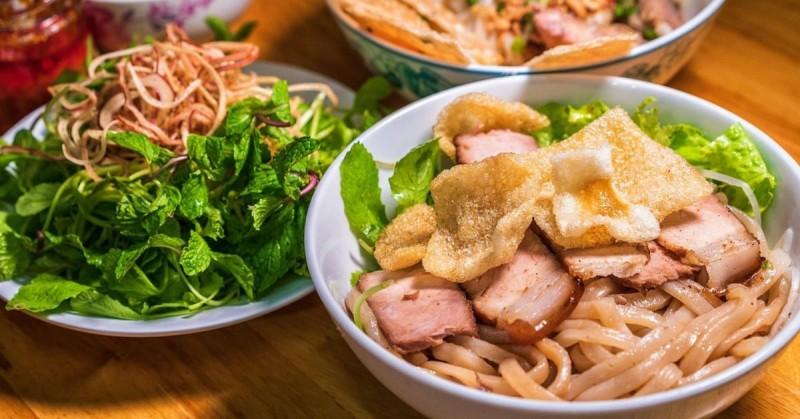
Cao Lau - © Saigoneer
8. Banh Xeo
Le Banh Xeo, une crêpe croustillante du Delta du Mékong, est un délice sensoriel. La pâte grésille et crépite dans la poêle chaude, remplissant l'air d'un arôme irrésistible. Fait de farine de riz et de lait de coco, la crêpe est garnie de porc, de crevettes et de germes de soja, puis repliée en un croissant doré. Le Banh Xeo est bien plus qu'un simple plat ; c'est une performance vivante qui laisse une impression durable.
Le Banh Xeo, qui signifie "gâteau qui grésille", porte bien son nom avec son délicieux processus de préparation. Un vendeur habile fait tourner la pâte dans la poêle, créant une fine coquille croustillante. L'arôme de la garniture attire les passants, mêlant la crêpe croustillante à la garniture savoureuse. Enroulé dans des feuilles de laitue fraîches et trempé dans une sauce de poisson acidulée, le Banh Xeo offre une symphonie de saveurs et de textures, capturant la dynamique culture de la street food du Sud du Vietnam.
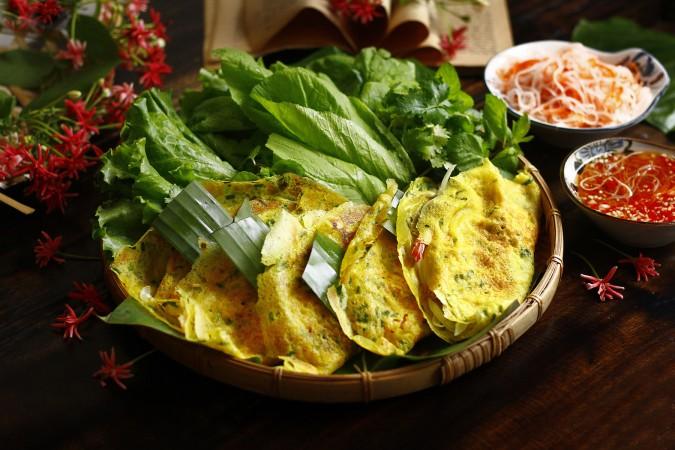
Banh Xeo - © VnExpress
9. Bun Bo Hue
Le Bun Bo Hue, originaire de la ville de Hue, offre une aventure gustative audacieuse et épicée. Un bol rempli de tranches de bœuf tendres, de jarret de porc et de saucisses épicées baigne dans un bouillon riche et savoureux. La pâte de crevettes ajoute une profondeur unique, tandis que les herbes fraîches et les légumes apportent une fraîcheur vibrante. Le Bun Bo Hue incarne les saveurs complexes et diverses du Sud du Vietnam.
Célébrant l'héritage culinaire royal de Hue, le bouillon, mijoté avec des os de bœuf et de la citronnelle, crée une base riche et aromatique. La pâte de crevettes ajoute une saveur umami unique, distinguant le Bun Bo Hue des autres soupes de nouilles. Déguster ce plat copieux lors d'une soirée fraîche, avec la chaleur du bouillon et la piquant de la pâte de chili, procure une expérience réconfortante. Le Bun Bo Hue est un incontournable pour explorer les saveurs audacieuses et complexes du Sud du Vietnam.
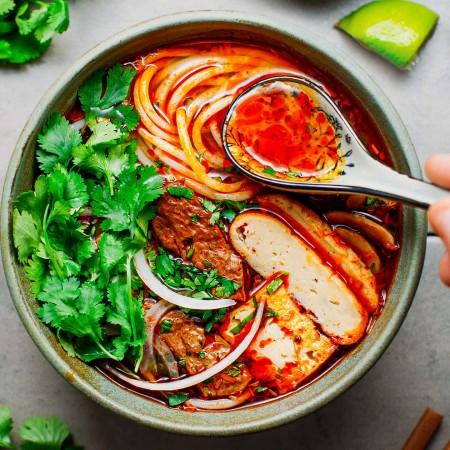
Bun Bo Hue - © h2tfood.vn
10. My Quang
Le My Quang, ou nouilles à la mode Quang, se distingue par sa présentation vibrante et ses saveurs riches. Des nouilles de riz jaunes, garnies de protéines comme des crevettes, du porc, et même des grenouilles, sont décorées d'herbes fraîches, de cacahuètes écrasées et d'un bouillon mijoté. Le My Quang célèbre la créativité culinaire du Sud du Vietnam, transformant des ingrédients simples en un chef-d'œuvre.
Les nouilles à base de farine de riz infusée au curcuma donnent au My Quang sa couleur et sa saveur distinctives. Le bouillon intensément savoureux, mijoté avec des crevettes, du porc et des épices aromatiques, complète parfaitement les nouilles. Chaque bol, garni d'herbes fraîches, de fleurs de bananier et de cacahuètes croquantes, crée un festin pour les yeux et le palais. Le My Quang, servi avec des crackers de riz au sésame croquants, illustre l'ingéniosité et la créativité de la cuisine du Sud du Vietnam.
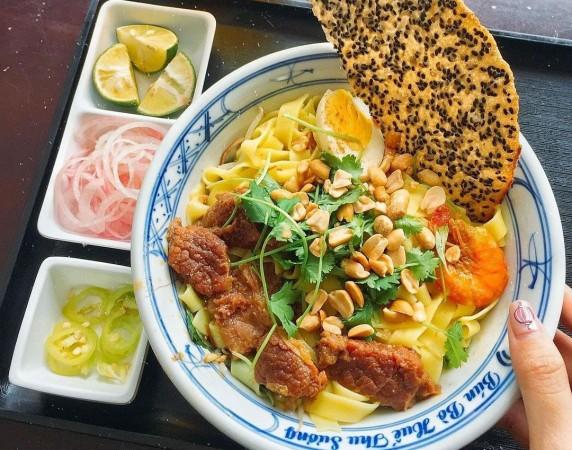
My Quang - © rassembler
Conclusion
La cuisine vietnamienne est une tapisserie vibrante de saveurs et de textures, bien au-delà du pho et du banh mi. C'est un voyage culinaire qui reflète le riche patrimoine culturel et la diversité régionale du pays. Si vous êtes prêt à explorer les délices gastronomiques du Vietnam, lancez-vous dans une aventure culinaire avec Tweet Tours, où vous pourrez savourer le meilleur de la cuisine vietnamienne.
Des articles pour vous

Explore Fukushima - Japan Travel, Asia
Nestled in Japan's scenic Tohoku region, Fukushima offers travelers a unique blend of historical charm, cultural richness, and natural beauty. Known for its stunning landscapes and welcoming communities, Fukushima is an excellent destination for those seeking an authentic Japanese experience beyond the bustling metropolises. Renowned for its diverse attractions, from ancient castles and hot springs to vibrant festivals and picturesque countryside, Fukushima offers a great opportunity for cultural and historical exploration for anyone who loves Japanese culture.
Population: Approximately 1.8 million in 2023.
Economy: Specializing in the seafood and fishing industries, Fukushima, with its historical impacts, now continues to thrive as one of the most developed and largest economies in Japan.
Landmarks: Famous for Aizu-Wakamatsu Castle, Fukushima City Historical Museum, and Ouchi-juku.

La symphonie saisonnière de l'Inde : Révéler les meilleurs moments pour explorer le sous-continent
Les traditions anciennes dansent avec les merveilles modernes dans une terre où les épices et l'encens embaument l'air, et chaque recoin cache une histoire prête à être découverte. L'Inde, vaste et diverse, se déploie comme un monde miniature en soi. Mais quand devriez-vous entreprendre ce voyage épique ? Rejoignez-nous pour un tourbillon à travers la tapisserie saisonnière de l'Inde et trouvez le moment parfait pour votre aventure.

Voyage culinaire à travers la Chine : Savourez les saveurs diversifiées
Des rives subtropicales de Canton aux steppes balayées par le vent du Xinjiang, le vaste paysage de la Chine est une tapisserie de saveurs, chaque région mettant en avant ses propres trésors culinaires. Avec plus de 2000 miles séparant les palais de dim sum du sud des étals de kebabs du nord-ouest, et des woks crépitants entre les deux, la diversité gastronomique de la Chine est véritablement inégalée. Alors, prenez vos baguettes et embarquez pour une aventure gourmande à travers les plats les plus délicieux du Royaume du Milieu !

Vivez l'expérience à bord du RV Indochine II - Une croisière sur le Mékong
Le RV Indochine II est un navire de croisière fluviale de luxe, offrant un voyage inoubliable à travers de nombreuses attractions le long du fleuve Mékong. Construit en 2017, ce vaisseau haut de gamme allie élégance coloniale et commodités modernes pour créer un environnement à la fois confortable et élégant pour son équipage et ses passagers. La taille intime du navire en fait le choix idéal pour ceux qui recherchent une expérience de croisière plus personnelle tout en explorant la culture, les paysages et le patrimoine riches du Vietnam et du Cambodge. Que vous admiriez le paysage depuis votre balcon privé ou que vous dégustiez une cuisine locale authentique, le RV Indochine II promet une aventure exotique hors du commun.

Assistez à la pêche sur pilotis au Sri Lanka
Le Sri Lanka, réputé pour ses plages magnifiques et son riche patrimoine culturel, abrite une tradition unique qui captive les voyageurs depuis des siècles : la pêche sur pilotis. Cette pratique ancienne, transmise de génération en génération au sein des communautés côtières, allie art et nécessité, offrant un aperçu d'un mode de vie intimement lié aux rythmes côtiers de l'île. La pêche sur pilotis au Sri Lanka n'est pas simplement un moyen de capturer des poissons ; c'est un emblème culturel, incarnant la résilience et l'ingéniosité des communautés de pêcheurs sri-lankaises.

À l'assaut des sommets : guide du randonneur de l'Himalaya
Lorsque les premiers rayons du soleil teintent les sommets enneigés de doré et de rose, vous êtes au seuil de l'aventure. Bienvenue dans l'Himalaya, où chaque pas est une immersion dans le plus grand spectacle de la nature. Avec Tweet World Travel comme guide, préparez-vous à un trek d’aventures, qui éveillera vos sens et vous transformera à jamais.
